The Plain of Reverse Tulips, Koohrang
In the heart of the Zagros Mountains, where snow-capped peaks give way to valleys full of life, lies a breathtaking plain that comes alive every spring. This beautiful and unique place, known as the Plain of Reverse Tulips in Koohrang, transforms into a vast sea of captivating red and orange flowers, all with their heads bowed toward the ground. It stands among nature’s most breathtaking and memorable sights, a fragile and extraordinary treasure nestled in the western mountains of Iran. This natural masterpiece attracts travelers, nature lovers, and photographers from all over the country and even beyond. But what makes this plain so special? And why do people draw to it every year, despite the cold mountain air and long journey? Let’s take a look at the location, story, and silent beauty of the reverse tulips in Koohrang. Join us in this exploration.
The Plain of Reverse Tulips Location
The Plain of Reverse Tulips is located in Koohrang County, in Iran’s Chaharmahal and Bakhtiari Province. Koohrang is a mountainous region known for its rivers, waterfalls, and lush landscapes. The region is located at a high altitude, which means that spring comes late here, usually in April or early May. But when it does, it arrives with a dazzling display of colors.
To reach the plain, you must travel about 90 kilometers west of Shahrekord, the provincial capital. The road winds through valleys and mountain passes.
Along the way, visitors can enjoy views of dense oak forests, snow-filled rivers, and grazing flocks of sheep. Traveling to the plains is an experience in itself, filled with quiet charm, scenic beauty, and a refreshing break from the noise and rush of daily routines.
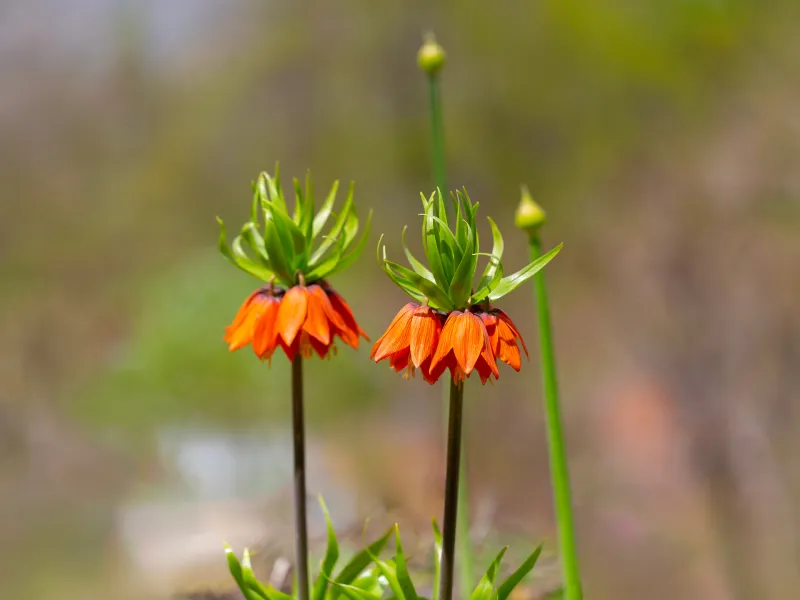
The Reverse Tulip Plain is usually found near Bazoft and Chelgerd, two small and beautiful towns in the region. These areas are home to the Bakhtiari nomads, whose traditional lifestyle and warm hospitality add cultural depth to the natural experience.
A Flower That Bows Down
The reverse tulip, known in Persian as “Laleh-ye Vajgoon”, is a unique flower that, unlike most flowers that face the sun, bends its head downward. Its bell-shaped petals hang like chandeliers, and its sturdy stem supports the weight with quiet elegance.
Known scientifically as Fritillaria imperialis, the reverse tulip naturally grows in the mountainous regions of Iran, as well as parts of Turkey, Afghanistan, and the Himalayan range. But it is in the mountains of Koohrang that these flowers grow in large numbers, creating an entire plain of fire-like color.
Each flower blooms for only a short time, usually two to three weeks, making its presence even more special. The petals are usually red or orange, sometimes yellow, and have delicate veins running through them. Below the flower, a ring of green leaves hangs like a small crown.
When the wind blows gently, the entire field seems to sway like waves in a silent sea. Because the reverse tulip is both beautiful and rare, it is a protected plant in Iran. Visitors are asked not to pick the flowers and damage the fragile ecosystem so that future generations can witness this seasonal miracle.
The Plain of Reverse Tulips Info
For those who plan to visit the Plain of Reverse Tulips, there are a few important things to keep in mind to have a better visiting experience. First, the blooming season is short and depends on the weather.
The best time to see the flowers is usually from mid-April to early May. If the winter has been long and cold, the flowers may bloom a bit later. If spring comes early, it may come even earlier. So it is best to check with local guides or tourist offices before traveling.
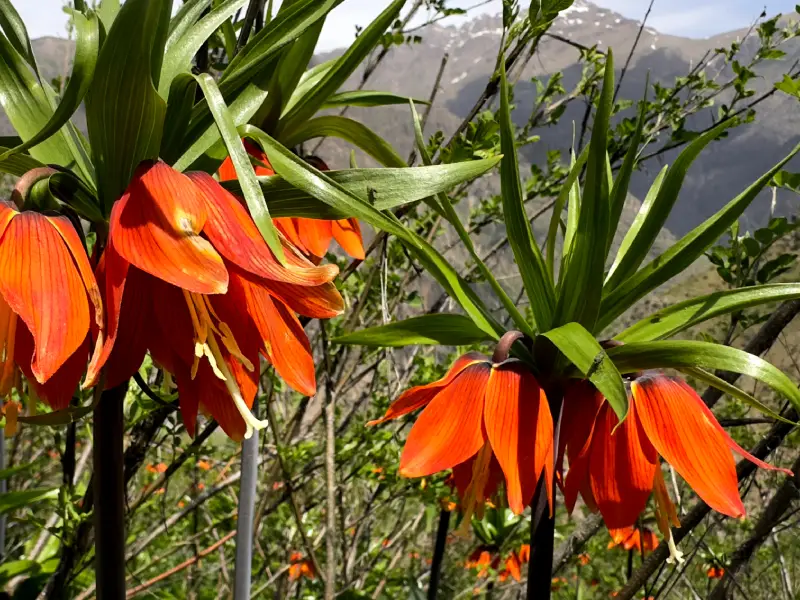
Second, the weather in Koohrang can still be quite cold during spring, especially in the early morning and late evening. It is advisable to bring warm clothing, comfortable shoes, and a quality camera. The light around sunrise and sunset is great for photography, especially if you want to capture the golden glow on the petals.
Many travelers prefer to camp nearby or stay in small guesthouses run by local families. This allows them to experience not only the flowers but also the culture of the region. Traditional Bakhtiari music, home-cooked food, and friendly conversations make the visit more memorable.
One can also visit other attractions of Koohrang, such as the Koohrang Tunnel, Sheikh Ali Khan Waterfall, and the icy springs that feed the Karun River. Each destination adds a different beauty to the trip.
Reverse Tulips Plain in Koohrang
For photographers, the Plain of Reverse Tulips is nothing short of a dream. The contrast between the red tulips and the white mountain peaks in the background creates a powerful visual story. The morning mist, sparkling dew, and dramatic lighting make the scene even more magical.
Some visitors climb the surrounding hills to take wide-angle shots of the entire field, while others get up close to the flowers to capture the delicate patterns on each petal. Wildlife lovers may also spot birds, butterflies, and even small foxes moving silently through the grass.
While drones are sometimes used to capture aerial views, it is important to fly them respectfully and not disturb the tranquility of the area or the nesting birds. This field is not just a photo opportunity; it is a living, breathing part of nature and deserves to be looked after.
A Cultural and Spiritual Experience
Beyond its physical beauty, the plain also carries a spiritual feeling. Many visitors speak of the deep peace they feel when walking among the flowers. The way the tulips hang their heads has led some to call them “mourning tulips” or “weeping flowers.” In Iranian folklore, they are sometimes associated with ancient stories of love, loss, and the cycle of life.
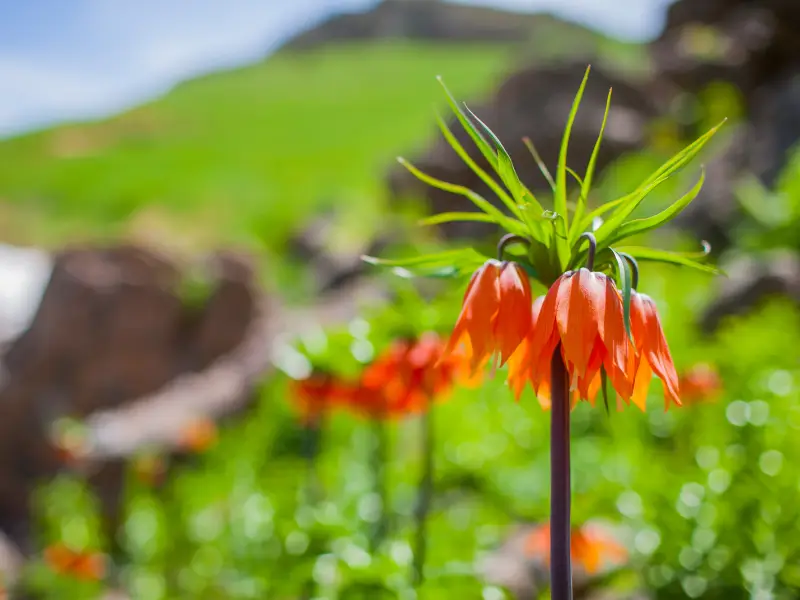
Local poets and artists have long been inspired by the reverse tulip. It appears in traditional crafts, carpet designs, and songs. Even those who are not usually moved by flowers often find themselves moved by the quiet humility of these blooms.
To the Bakhtiari people, this plain is more than just land; it is a cherished part of their ancestral roots and cultural identity. They cherish it not only as a tourist attraction, but also as a sacred landscape tied to their identity. Their stories and songs bring the plain to life in a way that words cannot fully describe.
Souvenirs from the Plain of Reverse Tulips, Koohrang
The souvenirs from the Plain of Reverse Tulips in Koohrang include medicinal plants and wild vegetables that can be picked from the surrounding mountains and areas near the plain. These include mountain celery, wild leek, wild shallot (moosir), chavil herb, and ban-sorkh plant.
You can also get other local souvenirs such as traditional dairy products, Koohrang honey, choqa (a traditional overcoat worn by Bakhtiari men), Bakhtiari carpets, varis (a narrow handmade strip woven by Bakhtiari women), khorjin (a traditional woven saddlebag), and siah chador (the black tent that serves as a symbol of nomadic life). These items can be purchased from the surrounding villages or from the town of Koohrang.
The Plain of Reverse Tulips Photos
In today’s digital world, many visitors share their experiences online, and the Plain of Reverse Tulips has become a popular topic on social media. If you search for the plain of Reverse tulips photos, you will find countless images showing the view from every angle—wide-angle, close-up, aerial, and ground-level.
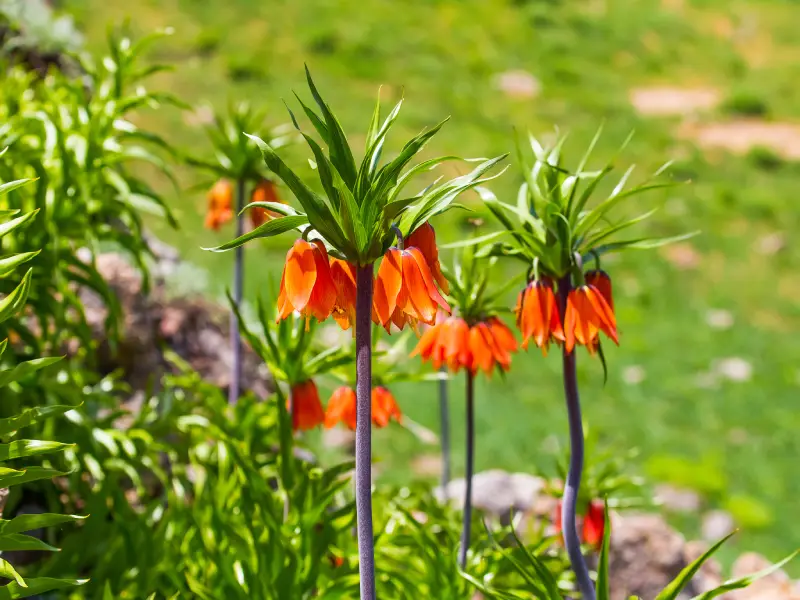
But no photo can fully replace the feeling of standing among the flowers, breathing in the cool mountain air, and hearing nothing but the gentle rustle of the wind and leaves. That is why, despite the popularity of the photos, the field still feels like a secret waiting to be discovered up close.
A Place to Protect
As more people discover this stunning plain, the need to protect it is growing. While tourism can be a source of income for local communities, it can also bring harm if not managed well. Picking flowers, walking off the paths, or leaving trash behind can damage the delicate balance of the ecosystem.
Fortunately, local authorities and environmental groups have taken steps to raise awareness and protect the reverse tulips. Signs, guides, and fences remind visitors to be respectful.
In recent years, the area has been part of an ecotourism effort that aims to balance between beauty and responsibility. By visiting the plain carefully, travelers become part of its story, not just as observers, but as helpers in keeping it alive.
Final Word
The Plain of Reverse Tulips in Koohrang is a place to feel, breathe, and remember. In a world that moves so fast, this field offers a pause of peace and beauty. At a time when so many natural places are disappearing, this field stands as a gentle reminder of what can still be preserved. Whether you come for the flowers, the mountains, or the stories, you will leave with a heart a little fuller and eyes a little more open. And perhaps, like the tulips, you too will find beauty in bowing your head to the earth, even for a moment.
Are you planning to travel to Iran and looking for an Iran resort? Consider Matinabad Eco-resort.

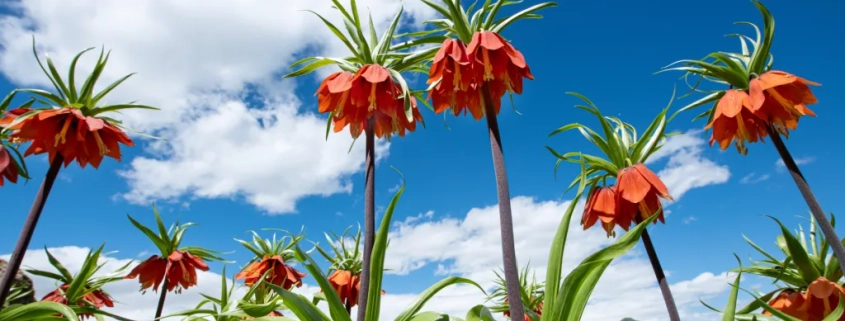



Leave a Reply
Want to join the discussion?Feel free to contribute!